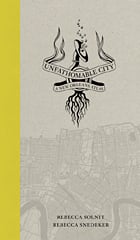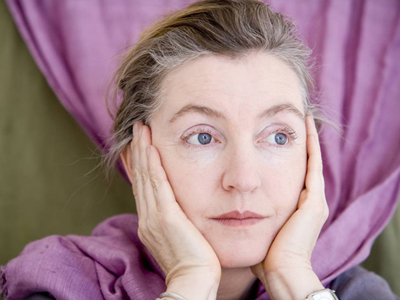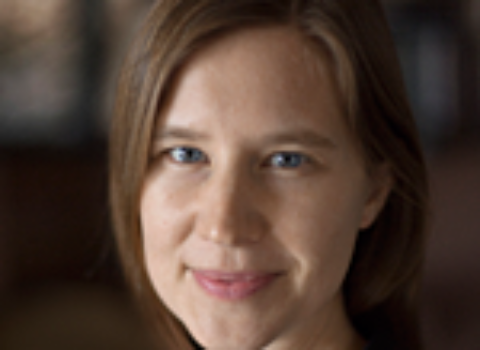The Faraway Nearby and Unfathomable City
Rebecca Solnit on how personal stories can fail to satisfy, the architectural space of the book, and the pleasures with which the landscapes of our lives are salted
Harper’s Magazine contributing editor Rebecca Solnit’s new book, The Faraway Nearby (Viking), takes readers to the distant depths of the self, by varying means: unknown landscapes, a sleigh, some rotting apricots, and her mother’s worsening Alzheimer’s disease. She also has a book forthcoming on November 4, Unfathomable City: A New Orleans Atlas (University of California Press), co-edited with Rebecca Snedeker, that lyrically and graphically explores the body politic of New Orleans, and that has in common with The Faraway Nearby a desire to investigate hidden aspects of well-known landscapes. I asked her six questions about the books and her writing, and she kindly answered them all.
1. In The Faraway Nearby, readers intimately experience the ideas associated with your experience of dealing with your mother’s Alzheimer’s, but are given few details about the personal story. What role did you want that narrative to play in the book?
Actually you are told a great deal about my story, but in the context of a larger investigation of stories and an attempt to define a larger sense of self than we are often given. The conventional self in most novels and memoirs is defined by private life, family life, and romantic life, and these are present in The Faraway Nearby, but that’s not all that’s there.
I think psychotherapy taught most of us how to tell our story and I find these stories often impoverished in their scope. I want more for myself and for everyone and for narrative. Who are we? Aren’t we also citizens, don’t we have souls and ideals, aren’t we also interfused with the natural world, biologically and psychically, don’t we extend far beneath, above, beyond that private realm? I think of that as analogous to a house; yeah, you live there, and crucial and sometimes sweet parts of your life take place there, but are we agoraphobics? Home is great to come back to, not so great to be on lockdown in. Friends, principles, ideas, writing itself, activist communities, and the natural world are great sources of strength and support to me, and that’s part of the larger territory staked out here.
I also see our lives being made out of the stories that we hear, that we live through vicariously, that we suspend our own lives to be absorbed in, the stories that guide and shape and feed and sometimes poison us, and I tried also to include the stories that were most illuminating for me in that phase the book describes: thus the several chapters that are not about me, except that I chose every word, interpretation, and emphasis, and chose the stories because they helped me think through my own or beyond my own; they are me even when they’re about Mary Shelley or Atagutaluk’s ordeal in the Arctic.
From The Faraway Nearby:
“To what extent, in which ways, are you a cannibal, and how careful are you about who you consume? We consume each other in a thousand ways, some of them joys, some of them crimes and nightmares.”
The author’s annotation:
Something that’s really important to me is to be clear that madness, criminality, forgetfulness, selfishness, cluelessness are not someone else’s attributes; the question is not who has those qualities but to what degree each of us possess them and how aware are we of that, and how gracefully and maybe compassionately do we try to work with those limits, stains, and sins that are our own, as well as other people’s. There’s such a tendency to render the world in binaries: you’re a paranoid schizophrenic and me over here I’m sane; you have a disease that makes you forget things and my memory is impeccable; you drive a car/eat meat/pay taxes and I am beyond reproach (or situated to reproach you in a left-puritan way). We’re all implicated. But as for the cannibalism, we do live off each other, from mother’s milk to blood transfusions and organ transplants to the way we are all enclosed in a world that is the result of human labor, human making, of clothes, of houses, of food, of systems. Maybe what I’m interested is the ways we consume each other that are gifts rather than thefts, that don’t involve destruction of the body or soul . . .
2. An essay runs the entire length of the book, italicized, one line at the bottom of each page. Why did the essay take that form?
I wanted to call attention to the fact that the codex, the bound book, is an architectural space through which we literally travel with hands and eyes, and that to read a book of this length is quite a journey. Interestingly, the form cannot be replicated on e-readers, where this fourteenth chapter just sort of floats as a bonus chapter. So in the paper books this thread provides continuity, literally — a single line of text that runs through all the other chapters (someone called it the crawl, as though the book was CNN, to my amusement). It also invites readers to decide how to read a book that has two narratives running parallel to each other; the thread can be read before, during, or after. And then, I was so smitten with the sentence I begin with, “Moths drink the tears of sleeping birds,” which is the title from a scientific report from a few years back, and this floating, stitching chapter was the right place for it.
3. The structure of The Faraway Nearby is purposefully associative and digressive. When do you know an essay should digress?
It really feels like following a path, or following a track — as in tracking animals or lost people. Stories lead to ideas, ideas lead to stories, the perception of patterns somehow happens in my mind in ways that aren’t visible even to me. The kid in The Sixth Sense said, “I see dead people.” Me, I see patterns of association and meaning and relation between things that are maybe far apart conventionally.
4. Much of this book is about the interior landscape of the self, brought up in conjunction with literal landscapes, mapping, mazes, etc. How did this metaphor aid the writing of the book? What effect do you think it has on readers?
I’ve been really interested in metaphor for a long time. For one thing, most of our metaphors and analogies are drawn from spaces, the natural world, the animal world, and our own bodies, and all these things can also represent each other — thus roads have shoulders and mountains have foothills and rivers have heads and coasts have headlands. We think through the material, the tangible, the visible, and I fear living in a more and more disembodied world in which metaphors grow alienated or just fade away. We need the natural and sensual world not only for ecological, biological, and maybe spiritual reasons, but for intellectual and imaginative ones.
And though “natural” is a weird word in this context, metaphors come naturally to me, and spatial metaphors are how I think. Thus, for example, I find it really valuable to think about the psyche as a landscape, and wrote about my mother’s that way: it’s not that you get over trauma, for example, as though you left it behind on the road, but that it’s somewhere on your landscape, a swamp or crater maybe. You can choose to hang out there, or pretend it’s not there and fall in, or be poisoned by what seeps out of it, or be fully aware of its location but dwell elsewhere.
Sometimes going to the tangible world can complicate metaphors gorgeously: Working with the photographers Mark Klett and Byron Wolfe in Yosemite (for what became our book Yosemite in Time: Ice Ages, Tree Clocks, Ghost Rivers), we realized that if time is a river — a rather stale metaphor — then this river moves its bed, has shallows, rapids, eddies, and backwaters, and maybe freezes over. The physical landscape demonstrated to us how uneven the progression of time is, and that the metaphor had to be grounded in the more literal complexity of rivers, which do not flow steadily. The Merced River had even changed its banks many times.
5. In the introduction to Unfathomable City: A New Orleans Atlas, you write about the eroding Louisiana coastline the same way you write about rotting apricots in The Faraway Nearby, offering hope in decay. So much of your writing is elegiac — how do you balance painful truths with hope, sentence over sentence?
The introduction to Unfathomable City was co-authored with Rebecca Snedeker, my co-director of that project. There is a kind of tragedy to all our lives, consisting of failures, of losses, of mortalities — but that sad landscape is salted with pleasures, with unions, with epiphanies and revelations, at least if you’re looking out for them. The trick is to hold both and maybe value both; we’re in a culture that’s desperate to be happy, which often turns into desperate to be shallow, numb, tuned out. And therein the depth and meaning is lost.
Which is the one thing you can hang onto when you lose everything else; like a lot of people I am much impacted by Viktor Frankl’s Man’s Search for Meaning, the account of what a sense of purpose and connection did even for prisoners in Auschwitz. My Paradise Built in Hell was about that joy of purpose, meaning, immediacy, solidarity, agency that often arises in the most dire circumstances, in wreckage and devastation and uncertainty. I wrote in that book,
We speak mostly of happy and sad emotion, a divide that suggests a certain comic lightness to the one side and pure negativity to the other, but perhaps we would navigate our experiences better by thinking in terms of deep and shallow, rich and poor. The very depth of emotion, the connecting to the core of one’s being, the calling into play one’s strongest feelings and abilities, can be rich, even on deathbeds, in wars and emergencies, while what is often assumed to be the circumstances of happiness sometimes is only insulation from the depths, or so the plagues of ennui and angst among the comfortable suggests.
I tried to write about this another way in A Field Guide to Getting Lost:
Lost really has two disparate meanings. Losing things is about the familiar falling away, getting lost is about the unfamiliar appearing. There are objects and people that disappear from your sight or knowledge or possession; you lose a bracelet, a friend, the key. You still know where you are. Everything is familiar except that there is one item less, one missing element. Or you get lost, in which case the world has become larger than your knowledge of it. Either way, there is a loss of control. Imagine yourself streaming through time shedding gloves, umbrellas, wrenches, books, friends, homes, names. This is what the view looks like if you take a rear-facing seat on the train. Looking forward you constantly acquire moments of arrival, moments of realization, moments of discovery. The wind blows your hair back and you are greeted by what you have never seen before. The material falls away in onrushing experience. It peels off like skin from a molting snake. Of course to forget the past is to lose the sense of loss that is also memory of an absent richness and a set of clues to navigate the present by; the art is not one of forgetting but letting go. And when everything else is gone, you can be rich in loss.

 6. In The Faraway Nearby, you write about the dangers of lying to oneself and of not knowing the lie, or story, that is part of one’s personal makeup. Your essay “Charting the Territories of Untruth,” in Unfathomable City, discusses lies and mysteries of a municipality in the same way. What kind of truth are you searching for in your writing? Where do you find it?
6. In The Faraway Nearby, you write about the dangers of lying to oneself and of not knowing the lie, or story, that is part of one’s personal makeup. Your essay “Charting the Territories of Untruth,” in Unfathomable City, discusses lies and mysteries of a municipality in the same way. What kind of truth are you searching for in your writing? Where do you find it?
Clarity about who we are, what we’re doing, who and what we impact, what we desire, the clarity that is not only not lying but seeing deeply into the patterns and meanings of things, that is a dedication of one’s life as well as a touchstone for the work. Where do I find it? I find that clarity scattered in fragments everywhere: in the fierce hope and commitment of movements like Occupy, in the words of writers like Jonathan Schell or Subcomandante Marcos, in poetry, in conversations with the people I love most, in the emotional nakedness of small children, in the patterns of the natural world.
To view one of the maps created for Unfathomable City by cartographer Jakob Rosenzweig and artist Jacqueline Bishop, please click here.






